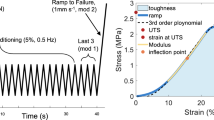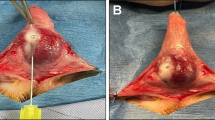Abstract
Peyronie's disease is a disorder of the penile connective tissues that leads to development of dense fibrous or ossified plaques in the tunica albuginea, causing penile deformity and painful erection. A biomechanical model of the penis was utilized for analyzing the mechanical stresses that develop within its soft tissues during erection in the presence of Peyronie's plaques. The model's simulations demonstrated stress concentrations around nerve roots and blood vessels due to the plaques. These stresses may irritate nerve endings or compress the vascular bed, and thus cause penile deformity and/or painful erection. The model was further used to elaborate the effects of different biological or artificial materials for reconstruction of the penis following plaque removal. Clinical applications of the present model can range from analysis of the etiology of the disease to assisting in the determination of optimal timing for therapeutic interventions and in the selection of patch material for penile reconstructions.
This is a preview of subscription content, access via your institution
Access options
Subscribe to this journal
Receive 8 print issues and online access
$259.00 per year
only $32.38 per issue
Buy this article
- Purchase on Springer Link
- Instant access to full article PDF
Prices may be subject to local taxes which are calculated during checkout





Similar content being viewed by others
References
Hamm B, Friedrich M, Kelami A . Ultrasound imaging in Peyronie disease Urology 1986 28: 540–545
Davis CJ . The microscopic pathology of Peyronie's disease J Urol 1997 157: 282–284
El Sakka AI, Lue TF . Peyronie's disease Curr Opin Urol 1998 8: 203–209
Gefen A, Chen J, Elad D . Stresses in the normal and diabetic human penis following implantation of an inflatable prosthesis Med Biol Eng Comput 1999 37: 625–631
Gefen A, Chen J, Elad D . Optimization of design and surgical positioning of inflatable penile prostheses Ann Biomed Eng 2000 28: 619–628
Anderson KE, Wagner G . Physiology of penile erection Physiol Rev 1995 75: 191–236
Yang CC, Bradley WE . Innervation of the human glans penis J Urol 1999 161: 97–102
Montorsi F et al. Vascular abnormalities in Peyronie's disease: the role of Color Doppler sonography J Urol 1994 151: 373–375
Culha M et al. The relationship between diabetes mellitus, impotence and veno-occlusive dysfunction in Peyronie's disease patients Urol Int 1998 60: 101–104
Levine LA, Lenting EL . A surgical algorithm for the treatment of Peyronie's disease J Urol 1997 158: 2149–2152
Chen J et al. Predicting penile size during erection Int J Impot Res 2000 12: 328–333
Dunsmuir WD, Kirby RS . Francois de la Peyronie (1678–1747): the man and the disease he described British Journal of Urology 1996 78: 613–622
Marzi M et al. Implant surgery in Peyronie's disease Urol Int 1997 58: 113–116
Venegas JG, Sullivan MP, Yalla SB, Vickers MA . Assessment and modeling of the physical components of human corporovenous function Am J Physiol 1995 269: 2109–2123
Pescatory ES, Jatzichristou DG, Namburi S, Goldstein I . A positive intracavernous injection test implies veno-occlusive but not necessarily normal arterial function. A hemodynamic study J Urol 1994 151: 1209–1216
Akkus E et al. Structural alterations in the tunica albuginea of the penis: impact of Peyronie's disease, aging and impotence Br J Urol 1997 79: 47–53
Mente PL, Lewis JL . Elastic modulus of calcified cartilage is an order of magnitude less than that of subchondral bone J Orthop Res 1994 12: 637–647
Gefen A, Chen J, Elad D . A biomechanical model of Peyronie's disease J Biomech 2000 33: 1739–1744
Hellstrom WJ, Reddy S . Application of pericardial graft in the surgical management of Peyronie's disease J Urol 2000 163: 1445–1447
Vincentelli A et al. Mechanical modifications to human pericardium after a brief immersion in 0.625% glutaraldehyde J Heart Valve Dis 1998 7: 24–29
Hastings GW . Cardiovascular biomaterials. Springer-Verlag: London 1992
Bitsch M, Kromann-Andersen B, Schou J, Sjontoft E . The elasticity and tensile strength of the tunica albuginea J Urol 1990 143: 642–645
Knoll LD, Furlow WL . Corporeal reconstruction and prosthetic implantation for impotence associated with non-dilatable corporeal cavernosal fibrosis Acta Urol Belg 1992 60: 15–25
Ganabathi K, Dmochowski R, Zimmern PE, Leach GE . Peyronie's disease: surgical treatment based on penile rigidity J Urol 1995 153: 662–666
Acknowledgements
Ms. Esther Eshkol is thanked for editorial assistance.
Author information
Authors and Affiliations
Corresponding author
Rights and permissions
About this article
Cite this article
Gefen, A., Elad, D. & Chen, J. Biomechanical aspects of Peyronie's disease in development stages and following reconstructive surgeries. Int J Impot Res 14, 389–396 (2002). https://doi.org/10.1038/sj.ijir.3900866
Received:
Accepted:
Published:
Issue Date:
DOI: https://doi.org/10.1038/sj.ijir.3900866



